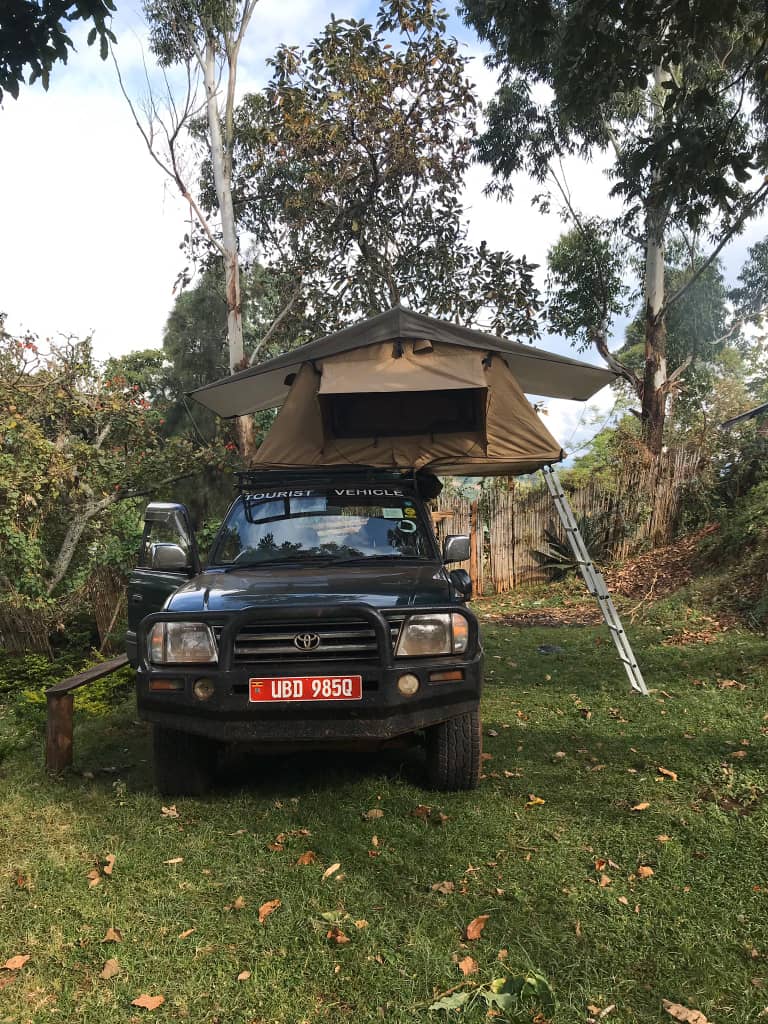
What an unbelievable adventure in to the wilds of truly stunning countries Rwanda and Uganda. The attention to detail, from the multiple email exchanges prior to the trip, to the support offered to us throughout our time in-country, really made us feel cared for. We asked for a 4×4 land cruiser with a rooftop tent and it was all done.
The purpose of the trip initially was to see the gorillas but it quickly became apparent that there was so much more to see and do. The itinerary was so well-planned and because of our guide’s local knowledge and contacts he was able to make slight tweaks to ensure we had the smoothest experience.
Highlights for me besides the obvious gorilla trek, were the evening game drives, the boat cruise along the Kazinga Channel, Kigali Genocide Memorial, the hospitality of the Rwanda and Ugandan people in general and Emma our guide in particular.
It has not always been possible to travel to Rwanda safely, since they had gone through a horrific genocide in 1994. In the 100 days of slaughter almost one million people, mostly Tutsi were killed by Hutu. But today, Rwanda is a welcoming country and completely safe to travel. The country is re-building itself from the genocide.
Volcanoes National Park is a high elevation mountain range, where 50% of all mountain gorillas live. Dian Fossey made the area famous when she did her studies there. Because of successful conservation programs the population of these primates is actually increasing. One of the driving engines of this conservation program is the large financial input of a tightly controlled visitation program.
For a pretty steep price $1500 per person, eight people can trek into the mountains with trackers, guides and porters to spend one hour observing a family of gorillas up close and personal.
Depending on where the gorilla families are on a given day, the trekking can take anywhere from 30 minutes to as far as 8 hours. It can be a very easy excursion of the toughest thing you have ever done. It all depends on where the gorilla families are and whether they stay put.
Gorilla trekking in Rwanda is perhaps one of the most rewarding wildlife encounters in Africa. Although chimps are more closely related to humans, gorillas seem to connect more to us as visitors. Nothing prepares you for being stared at by a gorilla.
They seem to be looking at us as much as we are looking at them. I was privileged to see gorillas in Volcanoes National Park about a dozen times, and each experience has been totally different from any other. One amazing experience was when the whole troop followed me down the mountain to the boundary of the forest after my time with them was up.
The next day we went into the same region, but this time to see another primate species, the golden monkeys. This is an old-world monkey species endemic to the high-altitude forest of Volcanoes National Park. Our trackers and guides found a family of them within an hour walk up the forest.
They feed largely on bamboo leaves and fruit. Unlike with the gorillas there was no tranquillity at all with these creatures. They were a lively bunch leaping from bamboo branches, frolicking on the floor and munching incessantly on bamboo leaves and other plants. The young were very playful and inquisitive, often jumping around our feet. It was pure joy to observe them while being completely ignored.
We then crossed to Uganda for mountain gorilla tracking in Bwindi Impenetrable National Park. The Forest is an area where mountain-gorillas live, so main goal was to see a family of gorillas.
After a pretty long walk through the beautiful green rain forest, it was really breath-taking to encounter gorillas in the wild. An experience I will never forget.
Bwindi is an unforgettable destination with about 459 gorillas live in the steep mountain-side jungle and several groups have been habituated to humans. An up-close encounter with these critically endangered giants is an experience like no other and anyone who has the chance shouldn’t pass up the opportunity.
Bwindi hosts an exceptional biodiversity, but the same factors that make gorilla tracking so difficult make spotting elephants, golden cat, giant forest hog, chimpanzee or any of the forest’s other large animals almost impossible.
Regardless of the wildlife, other than the gorillas, I did manage to see some smaller primates including black-and-white colobus plus plenty of colourful birds.
And not forgetting Uganda’s top safari park, Queen Elizabeth National Park is the one must-visit on any Ugandan safari. It still can’t boast wildlife numbers like the best Kenyan and Tanzanian parks, but there are plenty of big animals here and it has one of the highest biodiversity ratings of any nature preserve in the world.
This includes an incredible 612 bird species. Nearly every visitor takes a boat trip on the Kazinga Channel where the hippos and crocodiles are the stars, but buffaloes, elephants, lions, leopards and just about all other animals might be seen. Wildlife drives are best in this northern region, but the famous tree-climbing lions are only found in the distant Ishasha region.
Both Volcanoes and Bwindi parks are very smooth and well-managed operation, with strict rules to ensure gorillas aren’t adversely affected by visitors. These include, but aren’t limited to keeping a distance of 7m from the gorillas, although gorillas don’t know this, never tracking gorillas if you have a respiratory infection or diarrhoea, and never touching the animals.
